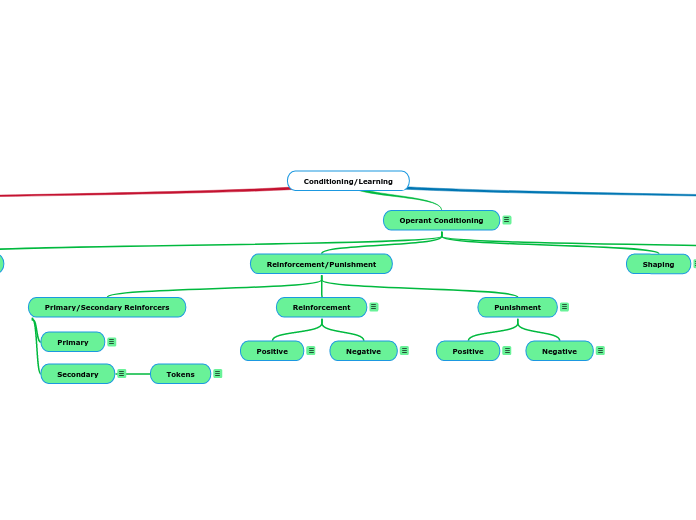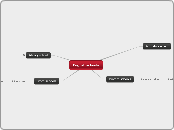Conditioning/Learning
Observational Learning/Modeling
The process of learning through observing, retaining and replicating behavior.
Models
The subject an observer looks upon to copy and learn from.
Symbolic
A fictional or real model displayed in a form of media. Such as a character in a film, book, comic, meme or game.
Verbal
The behavior is not done visually, but instead verbally. A person explains behavior verbally and it's up to the subject to interpret it.
Live
A behavior observed in person
Stages of Learning
Motivation
Motivation is whether or not the subject can be motivated to keep replicating their original observations.
Reproduction
If the subject can reproduce their original observations.
Retention
The ability of whether or not a person can retain what they observed. If not, they revert back to attention.
Time
Depending on the time given to observe, the subject could have an easier or harder time to retain and remember their observations.
Attention
How focused the subject is on a person or thing. How the person or thing being observed is perceived affects attention.
Interference
If there are other outside factors in an environment of observational learning, the subject could have a harder time focusing on the observations.
Operant Conditioning
A form of learning where there is a reward and consequence for certain behavior.
Reinforcement Schedueles
Partial Reinforcement
When the subject does not receive a reinforcer every time they display a behavior. Typically happens after a behavior has been learned.
Variable - Interval
Involves delivering a reinforcer after a varied amount of time.
Variable - Ratio
Reinforcing behavior after a varied number of responses
Fixed - Interval
Reinforcers are applied only when a set interval of time has elapsed
Fixed - Ratio
Responses or behaviors are reinforced only after a set number of times the behavior has occurred
Continous Reinforcement
When the subject receives a reinforcer every time they display a behavior.
Shaping
Reinforcers are added only when a target behavior has occurred.
Reinforcement/Punishment
Punishment
Decreasing the frequency of a behavior by punishing the subject for certain actions.
Negative punishments are punishments that are done by removing a subject's favorable outcome or object away from them after they've done a behavior. Such as a parent taking away a game after bad behavior.
Positive Punishments are not as the name implies. It means when a person presents an unfavorable outcome should a certain behavior be done. Such as spanking a child should they misbehave
Reinforcement
Increasing a behavior through adding or removing a substance or event.
Negative
Negative Reinforcement is brought on by removing a negative subject or event. Such as saying a child could get out of chores by getting good grades on their tests.
Positive
Positive reinforcement is when a favorable substance or outcome is brought by the subject's actions. Such as a child receiving praise or a toy for doing their chores.
Primary/Secondary Reinforcers
Secondary
Reinforcers that have no inherent value and only have reinforcing qualities when linked with a primary reinforcer. Examples would be praise from a parent or receiving money.
Tokens
A type of secondary reinforcer where you receive a token or other form of currency to trade in for a prize.
Primary
Reinforcers that have innate reinforcing qualities such as food or water.
Types of Behaviors
Operant
Behaviors that are made consciously.
Respondent
Behaviors that happen out of instinct or reflex. Examples of this behavior would be pulling your hand away from a hot stove. The occur automatically and involuntarily
Classical Conditioning/ Behaviorism
Classical Conditioning or Behaviorism is a form of learning or conditioning in which a subject learns to associate two events or stimuli that happen together repeatedly.
Response
A response in that is created or learned when no response existed before.
A response that occurs automatically or without thought when an unconditioned stimulus is present
Stimulus
Conditioned
A stimulus that was once a neutral stimulus but now leads to a response. Such as a dog siting after training them with treats.
Neutral
A stimulus that does not cause an automatic response. Such as hearing a fan turn on but feeling no wind, or an untrained dog not responding to instructions.
Uncoditioned
A stimulus that causes an automatic response. An example would be when a person shivers from cold wind.
Processes/ Principles
Higher Order Conditioning
Using a conditioned stimuli in order to create another secondary stimulus.
Discrimination
The ability to tell the difference between a conditioned stimuli and other unconditioned stimuli. Such as a conditioned dog being an able to tell the difference between a conditioned sound and its similar sounds.
Generalization
The tendency in which a conditioned stimulus reaps the same behavior in different similar stimuli. Such as a conditioned dog salivating at sounds similar to the conditioned stimuli.
Spontaneous Recover
When a behavior shows up again after the period of extinction
Extinction
When a condition response starts to disappear or decrease in frequency
Acquisition
The initial period of learning. When the subject starts to associate a neutral stimulus and an unconditioned stimulus.









